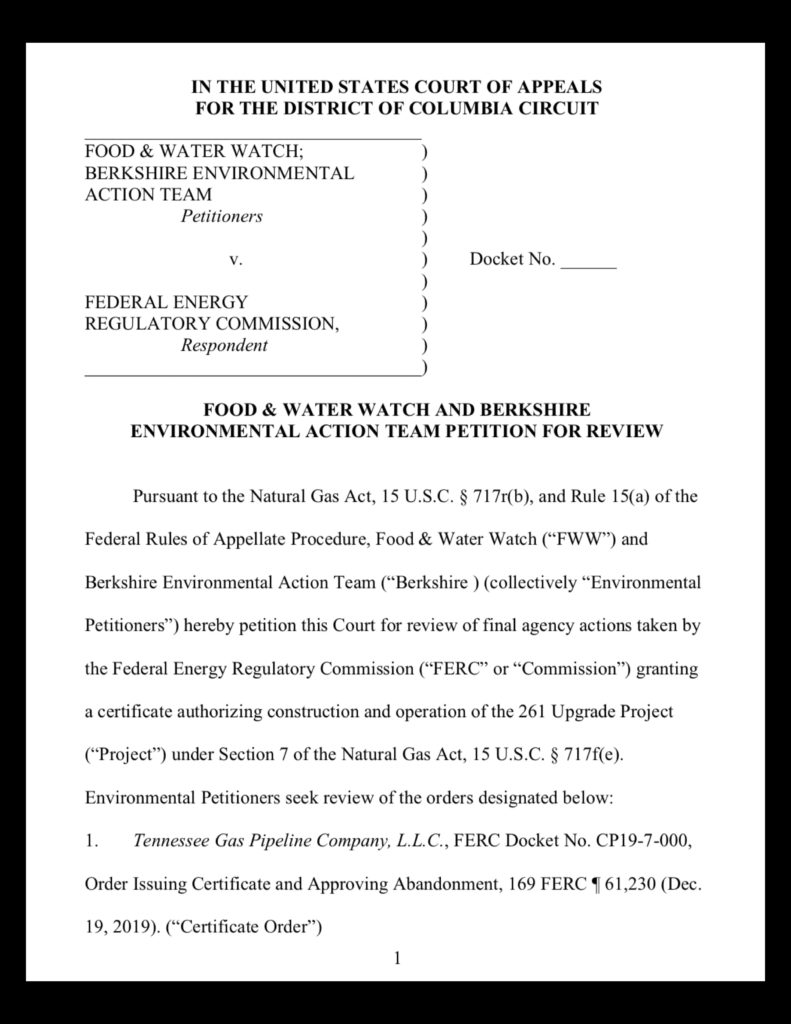Berkshire Environmental Action Team has partnered with Food & Water Watch to bring the Federal Energy Regulatory Commission (FERC) before the D.C. Circuit Court of Appeals. The case has already been getting national attention, and if we win, and we have every reason to believe we will, this will be a major blow to the natural gas infrastructure expansion that is currently underway across the country.
June 8, 2020, our case went to federal court to consider challenges to our (BEAT’s and Food and Water Watch’s) legal standing and to face any challenges by FERC to dismiss the case. Surprisingly, there were no motions to dismiss, nor were there any challenges to our standing. Next the case should move quickly to briefings on the merit of the case, and then on to the case itself. Keep your fingers crossed. We will keep you posted.
Here’s the background.
FERC is the federal agency that regulates the interstate transmission of electricity, natural gas, and oil, and issues permits, called Certificates of Public Convenience and Necessity, for construction of projects related to these industries, such as natural gas pipelines and compressor stations. In considering a proposal for a project, FERC is supposed to conduct an environmental assessment that includes any foreseeable effects the project may have on the environment. With climate change being our planet’s most pressing environmental issue, you would think that FERC’s deliberations would include the effects the proposed project might have on greenhouse gas emissions. Well they do, in part.
If we were to ask you what might you think are the foreseeable consequences of more natural gas pipelines and compressor stations, you might point to the fact that the natural gas flowing through the pipelines will eventually be burned by natural gas customers, leading to more carbon dioxide in the atmosphere and thereby accelerating climate change. These are called downstream effects, since they occur after the pipeline. Or you might suggest that increased pipeline capacity will lead to more natural gas sales, which will lead to more fracking, which is another source of greenhouse gases. These are called upstream effects, since they occur before the pipeline. Or if you are really thinking ahead, you might suggest, as the Massachusetts Attorney General has, that increased natural gas sales in our area will slow the expansion of renewable energy industries in our region, making it more difficult to combat climate change. Well, you will have to keep thinking, because although all three of these ideas are good ones, they are not among the factors considered by FERC when considering a permit application. So what do they consider? They consider the greenhouse gases that will be released by the construction of the pipeline and compressor station; in other words, the equipment used during the brief construction period.
This might surprise you, but it doesn’t surprise anyone familiar with FERC and its industry-friendly perspective. This agency has long been known as a rubber-stamp agency. In fact, since 1999, FERC has denied only two permits out of more than 400.
But this may be about to change. In 2017, Sierra Club brought FERC to court (Sierra Club v. FERC). The case involved a permit granted by FERC for the building of a pipeline in the Southeast U.S. As usual, FERC in their analysis ignored potential upstream and downstream effects of the project. The D.C. Court of Appeals found this unacceptable. The Court said that considering the foreseeable consequences was a required part of the environmental review under the National Environmental Policy Act (NEPA), and that the foreseeable consequences included upstream and downstream effects.
This law says that in addition to the direct effects of the project, the applicant must include indirects effects, which it defines as effects that are “…caused by the action and are later in time or farther removed in distance, but are still reasonably foreseeable. Indirect effects may include growth inducing effects and other effects related to induced changes in the pattern of land use, population density or growth rate, and related effects on air and water and other natural systems, including ecosystems.” The court says that this definition includes foreseeable effects on climate change. Victory! Right? Not so fast. Don’t underestimate FERC.
FERC’s response has been to continue to ignore upstream and downstream effects in permitting, arguing that nobody can foresee the effects of pipeline projects on climate change, and besides, they wouldn’t have all the information needed to conduct such an analysis because most of the needed information is held by third parties, such as their customers and the drilling companies.
This is where the next lawsuit against FERC comes in. Birckhead v. FERC (2019) was a lawsuit in which the D.C. Circuit Court of Appeals again had to tell FERC that upstream and downstream effects of a pipeline were a required part of the environmental review under NEPA. FERC argued that such an analysis could not be done. Climate change is complex, and nobody can foresee the consequences of a pipeline project. In order to attempt such an analysis, they would need information that is not accessible to them, but is held by their customers and their suppliers. The Court said that getting such information should be fairly simple, and that the analysis must be done. So now can we declare victory? No, not yet. It’s a subtle legal point, but the case before the court in Birckhead v. FERC did not directly ask about the inclusion of upstream and downstream effects, so although the court stated its position on this matter in its discussion of the case before it, it was not binding.
That’s where our lawsuit comes in. The case centers on a project in Agawam, Massachusetts that involves the construction of a couple of miles of new pipeline and a new mega-compressor station. Food and Water Watch is supplying the lawyers and legal expertise. BEAT is providing the legal standing, since we have been involved in the fight against this project in Agawam for some time. together we are arguing that once again FERC has refused to consider upstream and downstream effects of a project in issuing a Certificate of Public Convenience and Necessity. We believe we have given the Court every opportunity to restate their position in a case that specifically asks about upstream and downstream effects. We also will be asking the Court to hold FERC accountable for the full environmental analysis required under NEPA. In addition to the upstream and downstream effects, we believe that the new construction will pose a substantial health threat to the residents of the Springfield and Agawam region. The American Allergy and Asthma Association reports that the Springfield, Massachusetts area is the worst region in the country for asthmatics. Asthma is, of course, triggered and exacerbated by airborne pollutants, including those that routinely come from natural gas compressor stations.
June 8, 2020, our case went to federal court to consider challenges to our (BEAT’s and Food and Water Watch’s) legal standing and to face any challenges by FERC to dismiss the case. Surprisingly, there were no motions to dismiss, nor were there any challenges to our standing. Next the case should move quickly to briefings on the merit of the case, and then on to the case itself. Keep your fingers crossed. We will keep you posted.

